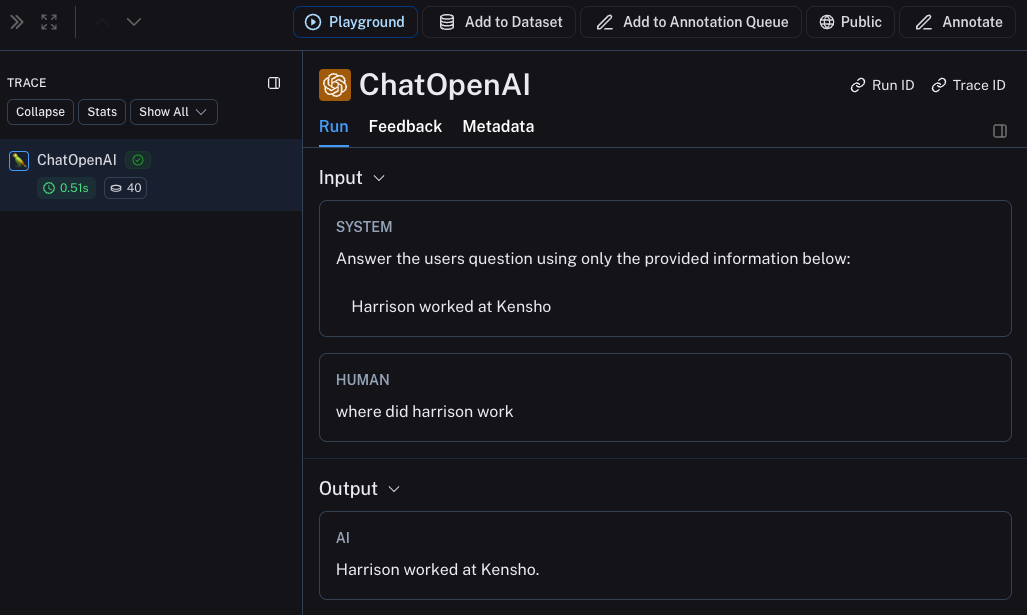#9 - Tracing in AI
 Mishal Alexander
Mishal Alexander
INTRODUCTION
In traditional web applications, engineers rely on tools like Loki for logging, Prometheus for monitoring server utilization, and Grafana for visualization in order to bring observability into their application to get more metrics. However, these tools aren't specifically designed for AI applications, which have unique observability challenges. AI systems need specialized monitoring to track various data, particularly tracing user journeys, capture detailed API usage metrics, identify potential bugs and debug application issues. In order to address the tracing challenges, we can either adapt existing tools with custom configurations and plugins or explore new tools specifically designed for AI, offering tailored features for tracking and analyzing AI-specific metrics. We will explore new AI tracing tools in this article.
LANGSMITH
Langsmith is a closed-source tool developed by the Langchain company. It offers a free tier and is particularly effective when used with Langchain products. To get started with Langsmith, you can use a free-tier API key, import the library, and create a wrapper for the OpenAI client. By marking functions with a ‘@traceable’ decorator, you can easily trace and monitor their usage. Langsmith also provides an option to gather feedback from users, and you can organize logs using ‘threads’ for better clarity. Langsmith works with both python and javascript.
How to use Langsmith:
Install Dependencies
“pip install -U langsmith openai”Get an API key [from their website]
Set the API key in the environment variables
Trace OpenAI calls
Wrap the function call which creates the OpenAI client with ‘wrap_openai()’ method like this -
Now all queries are tracked which can be viewed in the Langsmith dashboard like this:

Trace individual function or tool calls with ‘@traceable’ decorator like this:
[we just need to add it on top of every function declaration]
As we can see from the screenshot below, the ‘rag’ function (as declared above) call is traced and is presented in the dashboard.

Now, one concern with Langsmith is that the data is being sent to the Langsmith server to process and visualize. Wouldn’t it be better if there is an open source version alternative to Langsmith? There is one such tool and it is called - LangFuse.
LANGFUSE
LangFuse is an open-source tracing tool for monitoring AI usage. It allows self-hosting, which benefits organizations focused on data privacy. However, certain advanced features like RBAC, customer support, etc comes at an extra cost. LangFuse operates asynchronously, processing data in the background to avoid affecting app performance. It uses the 'clickhouse' database and ‘minio’ (open source version of AWS S3) in the background to work on the captured data efficiently.
How to use Langfuse:
Install dependencies
“pip install langfuse”Setup environment variables
[langfuse secret-key, public-key & host and OpenAI api key as suggested by langfuse]Instead of OpenAI, import the OpenAI client from the langfuse library
Trace tool calls with ‘@observe()’ decorator

See the data coming in the dashboard of langfuse UI

There are a few other options for tracing like - Helicone, Arize Phoenix, etc. Regardless, Langsmith and Langfuse are the most prominent tracer applications in AI which are commonly used by organizations.
CONCERNS
There are no noticeable performance impacts, such as increased latency, when using a monitoring application like Langsmith or LangFuse. These tools are designed to operate efficiently by performing tracking tasks asynchronously. This means that all monitoring activities occur in the background, without interfering with the main operations of your application. As a result, the end user experiences no delays or disruptions, ensuring a seamless and smooth user experience. This behind-the-scenes approach allows developers to gather valuable insights and data without compromising the performance or speed of their applications.
CONCLUSION
In this article, we took a brief look at the concept of observability in AI applications and saw the usage of two tracer tools - langsmith and langfuse. We’ve seen how to set them up to start gauging an AI application and how it works.
REFERENCE
Subscribe to my newsletter
Read articles from Mishal Alexander directly inside your inbox. Subscribe to the newsletter, and don't miss out.
Written by
Mishal Alexander
Mishal Alexander
I'm passionate about continuous learning, keeping myself up to date with latest changes in the IT field. My interest is in the areas of Web Development (JavaScript/TypeScript), Blockchain and GenAI (focusing on creating and deploying memory aware AI-powered RAG applications using LangGraph, LangFuse, QdrantDB and Neo4J). I welcome professional connections to explore new ideas and collaborations.